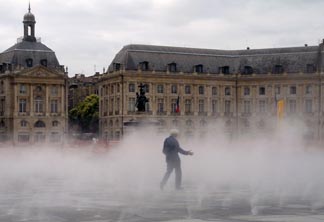If I recall correctly, the Seattle artist Jim Pridgeon had a concept to create a drawing in sky by unrolling a ___ mile long reflective mylar sheet in the lowest level of orbiting satellites around the earth. Depending on the time of day, the drawing would be more or less visible. Most visible at sunset.
At a global scale, Pridgeon’s sculpture would capture and redirect (reflect) the light of sun to make a cut in the sky. A crisp edge of brighter light is the first aesthetic act of the reflected surface.
Other aesthetic acts of reflection include the displacement a visual image into the reflective surface, the doubling of an image along an axis and the movement of an image against a stable background when the person moves. A game of image and bodily movement is always ready.
Of course, in the main, reflection is used by humans to know themselves. Especially the faces and especially as they appear to others.
Owen Morrel’s Lighthouse and Anish Kapoor’s Sky Mirror
It seems to me, without any scientific survey, that shinny things and reflective surfaces are more popular with artists. Perhaps visual artists have been influence by hip-hop artists. At least it is fun to think of Anish Kapoor’s work as civic “bling” with the similar spatial and cultural function. One on a chest or smile and the other on a plaza or doorway.
Also unscientific is my feeling that buildings with 100% heavily reflective glass walls are no longer popular. Now the glass (or metal) is modestly reflective and covering less of the building surfaces. The 1970’s and 80’s reflective building that attempted to disappear into the sky has, well, disappeared.
Photos from Corajoud website
Into this musing on reflection jumps French landscape architects, Claire and Michel Corajoud, and their “Water Mirror” in Bordeaux, France. I could not find enough English, but I think the miroir d’eau was completed last October.
Corajoud replaced the working docks on the Garonne River with a giant rectangle of ½ thick water. Just enough water over a black granite (?) plaza to create a surface large enough to reflect the entire 18th century Stock Exchange building. The mirrored images of the building at night have already become a photo tourist’s “must have” picture in Bordeaux.

A fog systems operates with and without the water. The scale of the site creates a miniature fog bank for more great photographs and helps the illusion of continuity of the water with the river like a misty infinity pool.
The elegant historic French idea of the central reflecting pool has been makes it participatory. The water mirror both forces people backwards to observe the reflection and then bring them together in the play of splashing water and hide-and-go-seek fog.
As stated above, the reflection of the mirror is to see ourselves and to see how others see us. This is also the perfect definition of the cultural role of the plaza. Did Corajoud intend symmetric reflection of definitions? He is French.
Public Art, Public Space

James Pridgeon describes his Reflective Work
Thank you for referencing this work. My art-in-space project was adopted as the symbol of the 1990 Seattle Goodwill Games and came close to realization with a dedicated Soyoz booster donated by Glavkosmos – the commercial side of the Soviet Space program – to launch the sculpture. This would have been seen by 3.5 billion people at dusk and dawn over a period of about 3 months. However, fundraising could not be finished in time to build the 10K (6 mile) long tethered sculpture so, although viable, the project was not launched. This sculpture used tethered inflatables based on early 1960’s Echo and Pageos satellites. The idea of unrolling mylar reflective sheets is attractive but poses a significant engineering challenge. It was suggested by several artists, including Ken Kesey, as part of a study I originated for NASA in 1984 as part of the Space Station Utilization Task Force on artist’s interest in going into space as part of the Space Station Program. It is interesting to consider the role reflection plays in our mythology and consciousness. Reflective bodies such as the moon and planets have to do with our earliest explorations of place, and lead ultimately to both literary and scientific thought, while our ability to recognize our own reflections, as distinquished from most other species, leads to our deepest questions about psychology and consciousness. It is interesting to me that an underlying aesthetic sense seems to inform both areas of inquiry. Thank you again for including this work in your discussion.